During times of uncertainty, carefully reviewing your CEO pay decisions for the 2020 fiscal year is more important than ever before. This article offers a first look at key data points to help serve as a guide.

As the COVID-19 pandemic presents unique challenges for companies across all industries, management teams and compensation committees continue to evaluate executive compensation plans to adapt to the current environment. During these unprecedented times, business leaders are making compensation arrangements that provide operational flexibility while retaining and motivating executives. (For advice on making mid-year adjustments and future pay decisions, see our article, A Framework for Making Executive Compensation Changes in 2020 and Beyond.)
Using data from Aon’s Total Compensation Measurement® (TCM) database, we took an early look at 2020 CEO pay disclosures from 178 companies to provide guidance to companies in their compensation planning. Our analysis offers the first opportunity for rewards professionals to preview pay decisions for the 2020 fiscal year, rather than pay decisions for 2019 disclosed in 2020 proxy statements. All CEOs in this report held the same role in 2019, and the four areas of CEO pay covered include:
- Base salary
- Target bonus
- Long-term incentives
- Target net total compensation (base salary plus target variable pay)
Base Salary
Base salaries for CEOs in 2020 increased by 2% compared to last year, slightly less than the salary increase across the broader employee population (3%). The largest salary increases — about 9% — were seen at companies with revenue between $1 billion and $2.5 billion, followed by 5% for companies with revenues of $5-$10 billion.
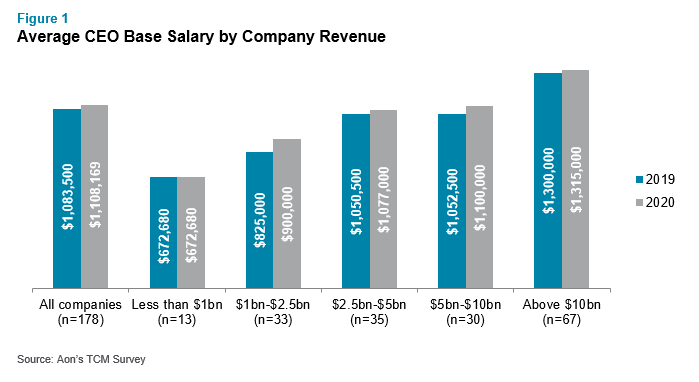
CEO salary increases were roughly the same across industries, with the exception of financial services, where salaries remained flat compared to 2019.
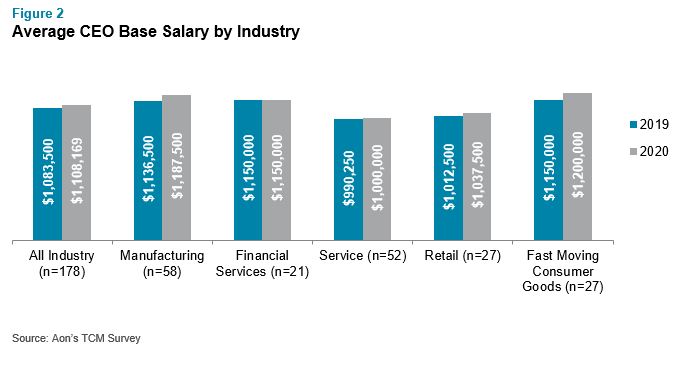
In response to COVID-19, 17% of companies in our analysis temporarily reduced their CEO’s base salary. Of those making reductions, nearly 50% reduced the CEO’s salary by 30% to 50%. CEOs at manufacturing companies saw the highest prevalence of salary reduction. Adjustments were roughly the same on average across all revenue sizes. (You can read more about executive pay reductions and restorations in our article, Pandemic Salary Cuts are Being Restored – But Not for Every Company.)
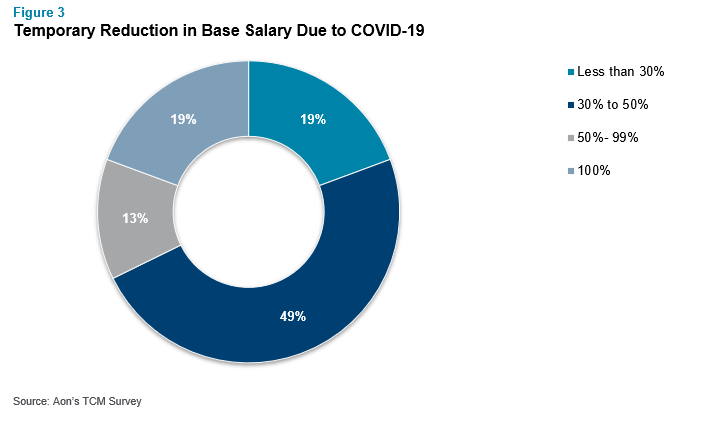
Short-Term Incentives
Apart from modest increases at companies with revenues above $10 billion, median target bonus opportunities remained flat at most companies.
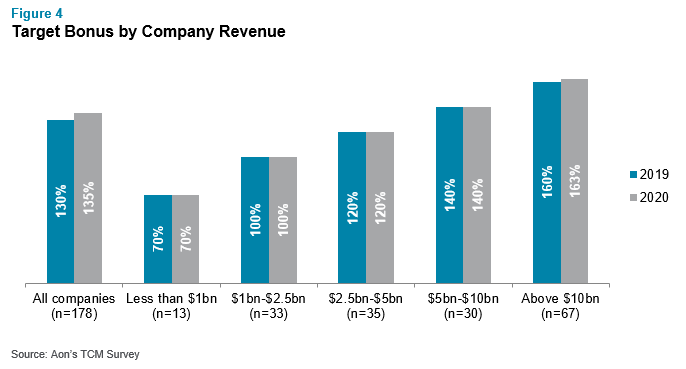
Although salaries at financial services companies remained flat, the industry saw the largest spike of target bonus opportunities, with an increase of 7%.
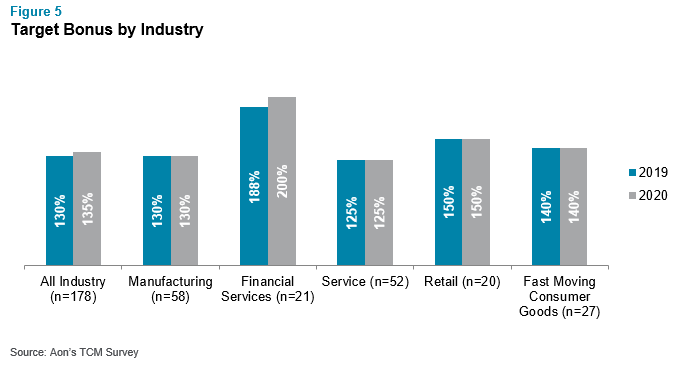
Only 3% of companies reported either cancelling or readjusting their CEO’s bonus awards in response to COVID-19 at the time their data was submitted. We noticed a minimal effect on short-term incentives, as most of the companies made annual payouts prior to the pandemic. Actual bonus payouts for the 2020 fiscal year remain uncertain and we recommend that companies continue to monitor performance throughout the year.
Long-Term Incentives
Among the 178 participating companies, 87% grant long-term incentive (LTI) awards to the CEO. The prevalence of LTI vehicles was generally unchanged year-over-year, with a slight decrease in the prevalence of stock options.
Overall, LTI as a percent of base salary increased roughly 2%; companies with less than $1 billion in revenue saw the largest increases. Less than 1% of companies have made changes to their LTI plans in response to COVID-19, however, firms continue to monitor grants for the 2021 fiscal year.
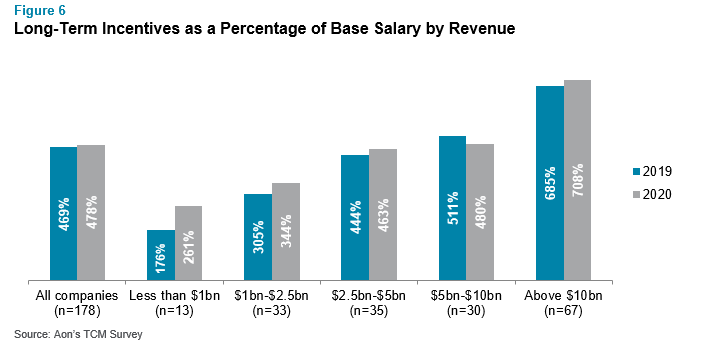
When viewing by industry, retail companies saw the largest increase in long-term incentives as a percentage of base salary in 2020.
Some LTI awards made in the spring of 2020 saw an immediate decline in value following the onset of the pandemic. We recommend benchmarking long-term incentive awards on the grant-date fair value to account for any immediate effects of rapid share price decline, including decrease in dollar value or increase in the number of shares granted.
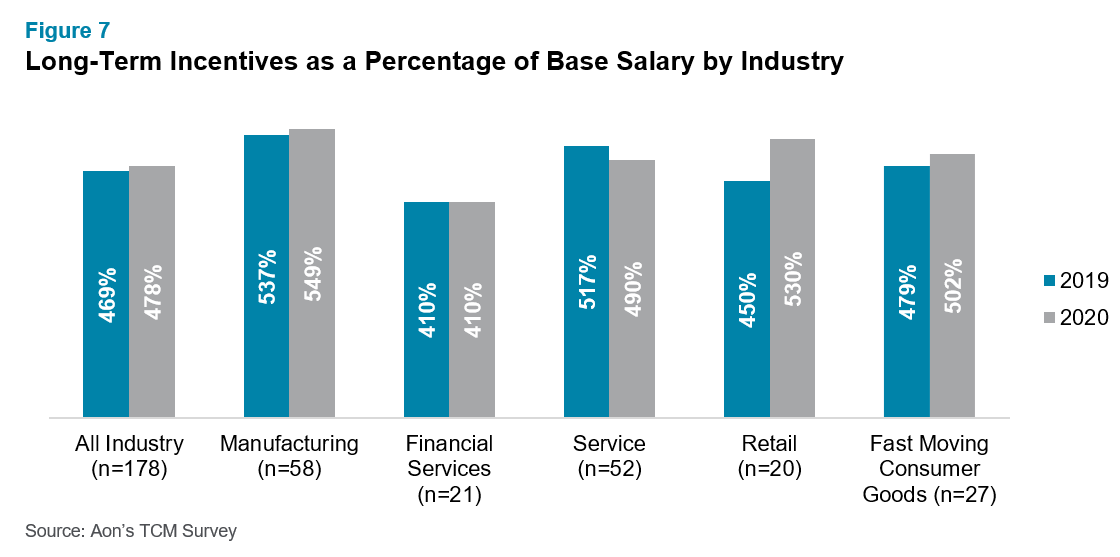
Target Total Compensation
The median target total compensation (TTC) for CEOs increased 5% from $7.77 million in 2019 to $8.16 million in 2020. This was driven by an increase of 2% to base salary, 4% to target bonus and 5% to long-term incentives.
Companies with revenues between $1 billion and $2.5 billion had the largest increase of TTC (5%). When examining TTC by industry, retail and service companies saw the largest year-over-year increases.
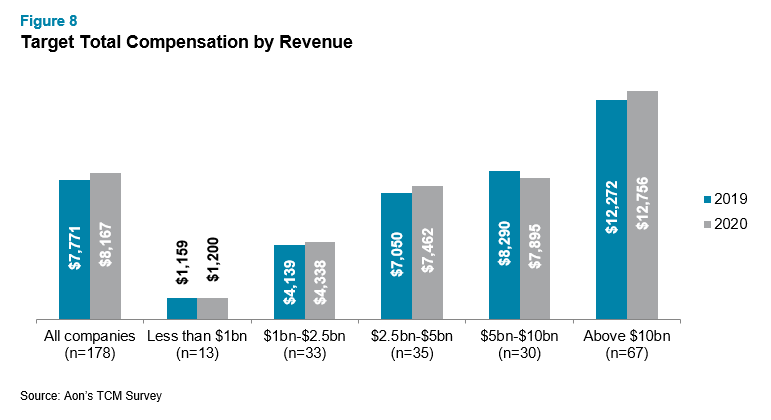
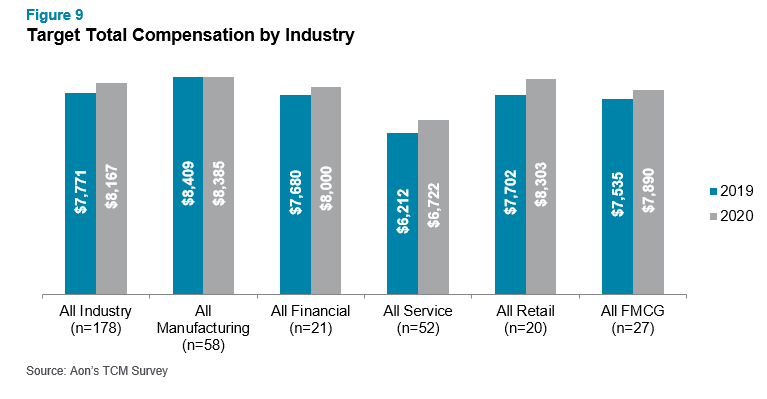
Next Steps
While CEO pay rose 5% from 2019 to 2020, this was lower than the 9% increase from the year prior. However, a 5% increase is more in line with historical norms. These increases in all components of pay suggest that the data was not heavily impacted by COVID-19 and can be used in benchmarking 2020 compensation levels. However, we do recommend that companies take into consideration the impact of COVID-19 when making decisions for 2021.
Participating in Aon’s TCM Survey provides access to key pay trends, including movements in total CEO pay year-over-year. The survey covers senior management and executive roles, management and individual contributor roles, as well as non-exempt roles.
To learn more about year-over-year pay trends and how to participate in our TCM Survey, please write to rewards-solutions@aon.com.
To read more articles on how rewards professionals can respond to the COVID-19 pandemic, please click here.
COVID-19 Disclaimer: This document has been provided as an informational resource for Aon clients and business partners. It is intended to provide general guidance on potential exposures, and is not intended to provide medical advice or address medical concerns or specific risk circumstances. Due to the dynamic nature of infectious diseases, Aon cannot be held liable for the guidance provided. We strongly encourage visitors to seek additional safety, medical and epidemiologic information from credible sources such as the Centers for Disease Control and Prevention and World Health Organization. As regards insurance coverage questions, whether coverage applies or a policy will respond to any risk or circumstance is subject to the specific terms and conditions of the insurance policies and contracts at issue and underwriter determinations.
General Disclaimer: The information contained in this article and the statements expressed herein are of a general nature and not intended to address the circumstances of any particular individual or entity. Although we endeavor to provide accurate and timely information and use sources we consider reliable, there can be no guarantee that such information is accurate as of the date it is received or that it will continue to be accurate in the future. No one should act on such information without the appropriate professional advice after a thorough examination of the particular situation.
Related Articles